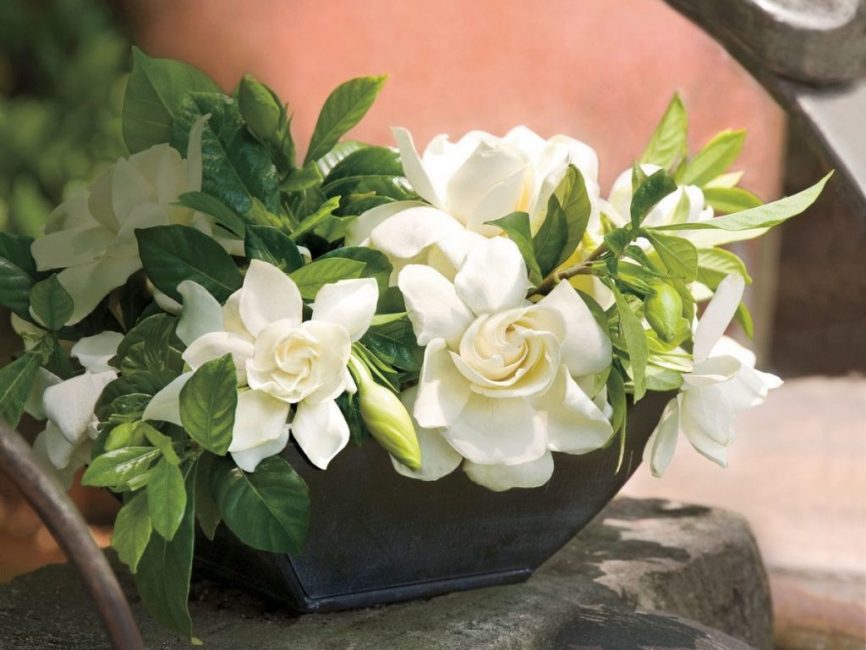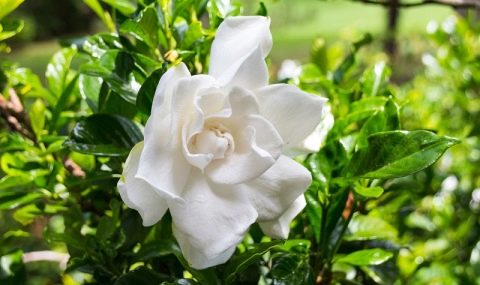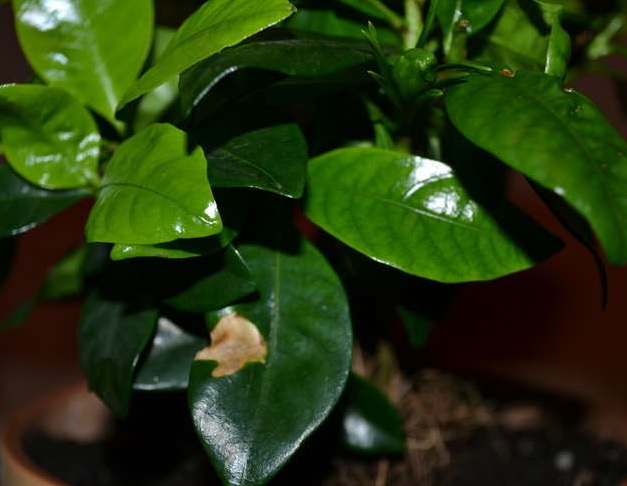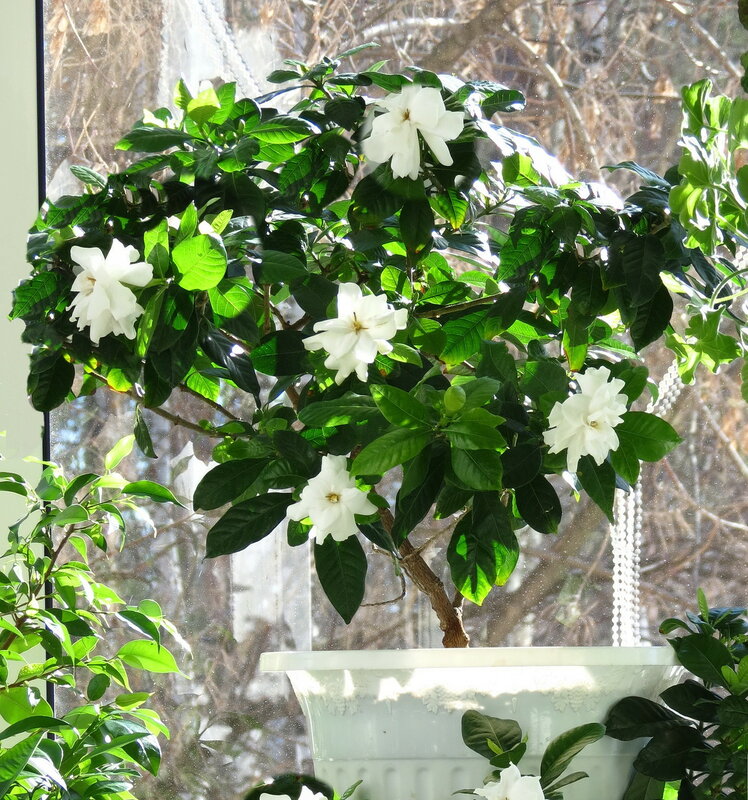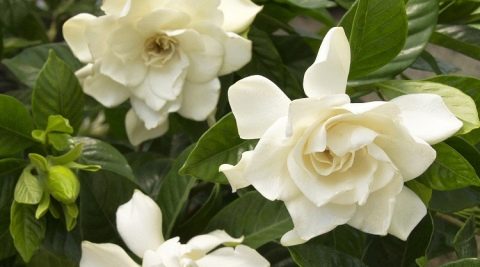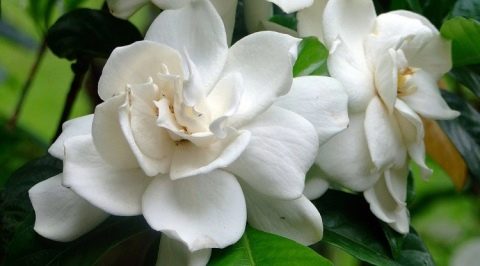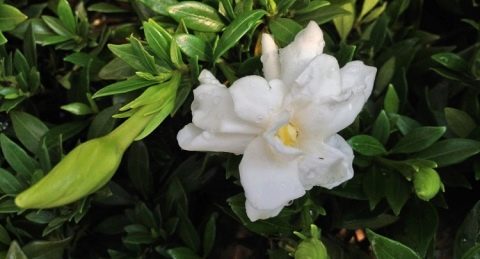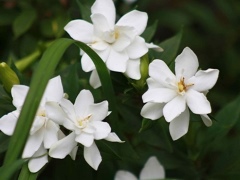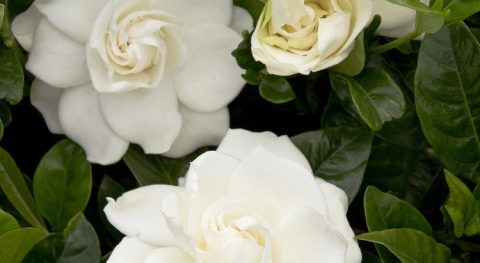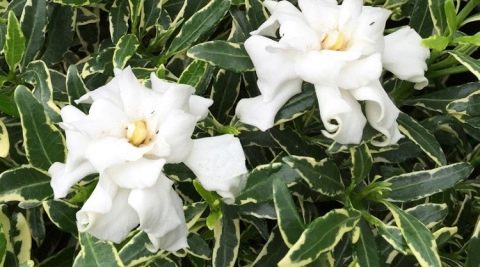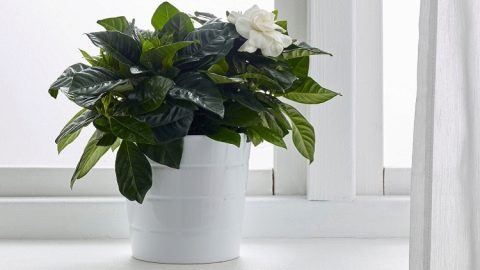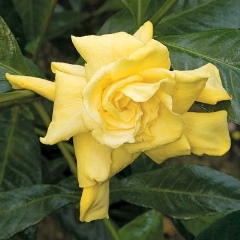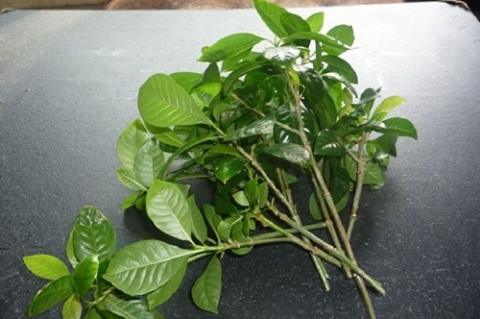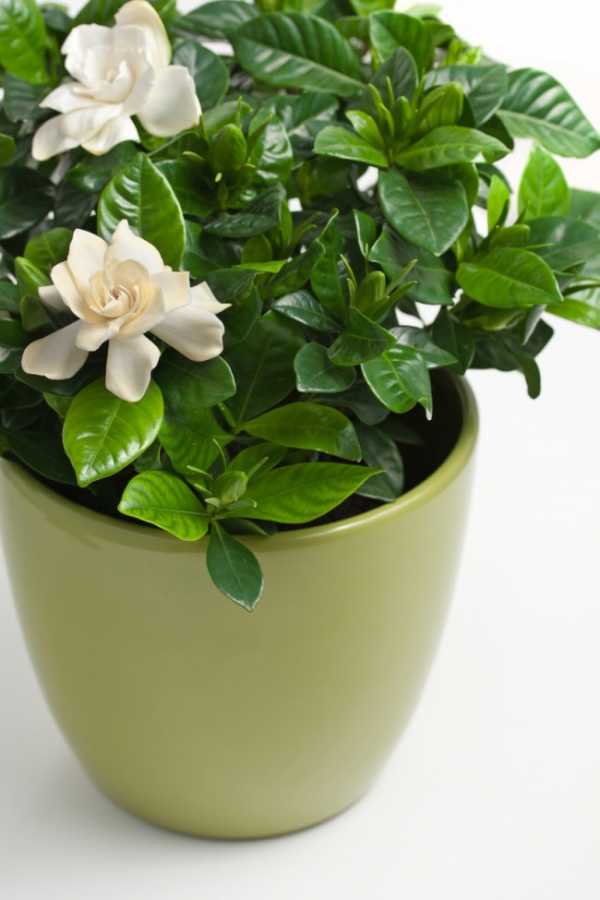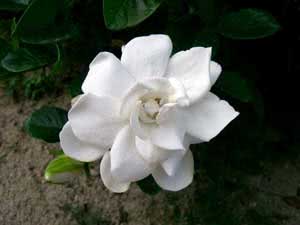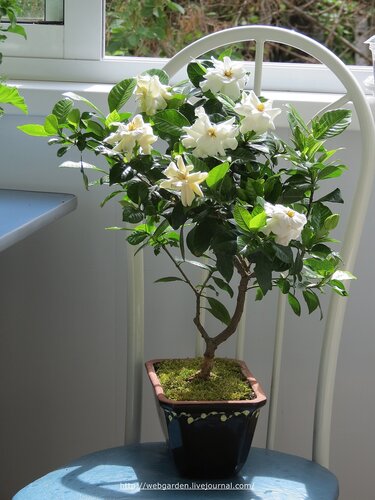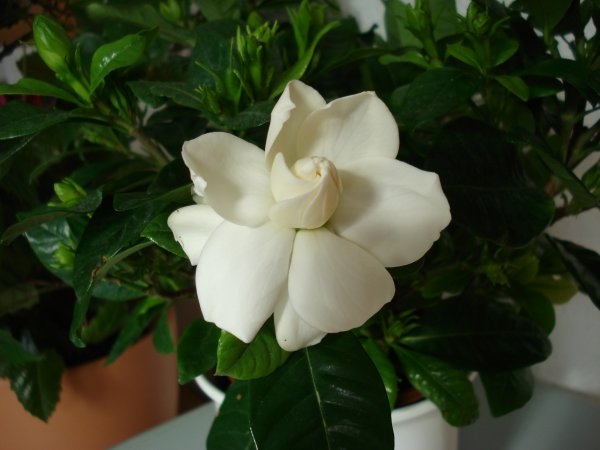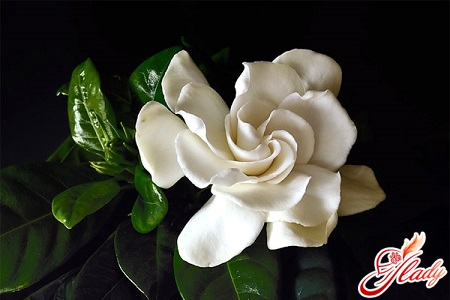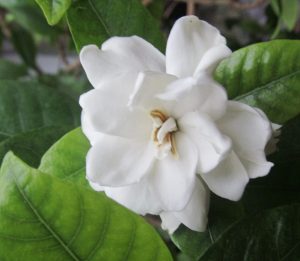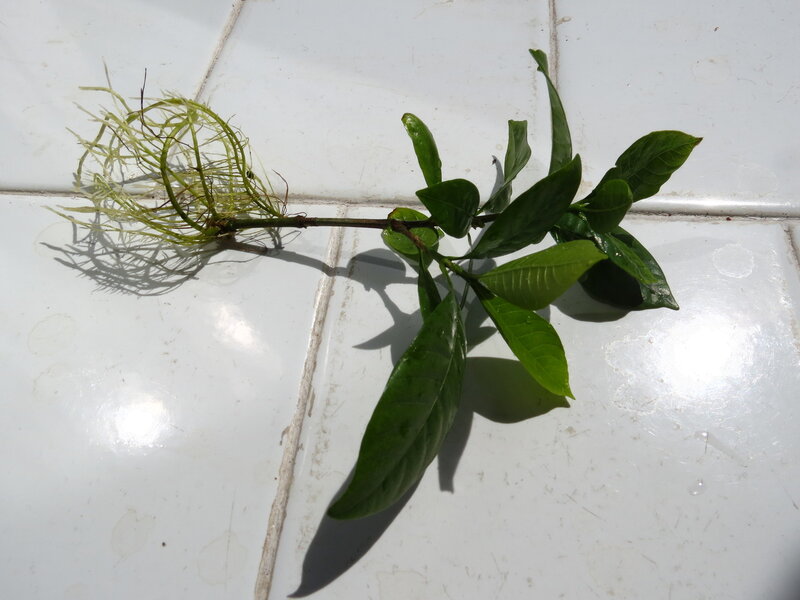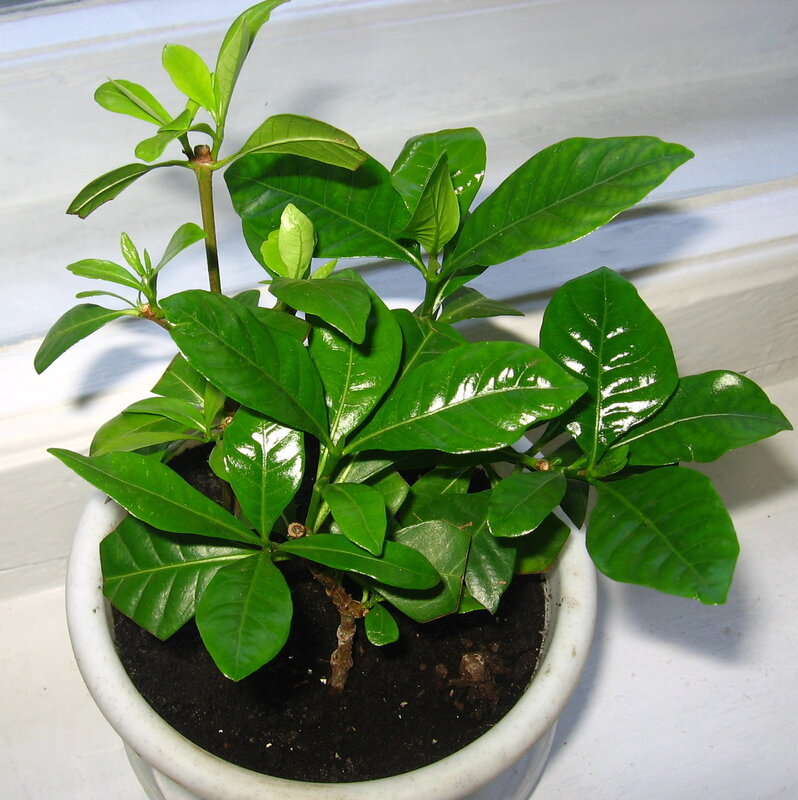How to propagate a flower
Although it is difficult to propagate a plant, it is possible. There are three ways to do this:
- layering;
- cuttings;
- seeds.
Rooting layers
- Peel back one of the shoots, the bark of which has not yet become woody.
- Cut it a lot on one side. The damage will promote root formation.
- Bend to the ground.
- Pin with a metal bracket.
- Sprinkle with substrate and moisten.
-
After six months, the rooted cut can be separated and planted in a permanent place.
Cuttings
This method is the most effective, and it is most often used by flower growers when propagating gardenia.
How to root a stalk (shoot)
-
Cut semi-lignified cuttings about 10 cm long. Cuttings can be made in the spring when the flower begins to actively grow. Also, a large number of cuttings can be obtained in the fall when pruning gardenia before dormancy. Planting material can be rooted in both spring and autumn.
- Dust the sections with Kornevin or another root stimulant.
- Fill a dish with a light substrate consisting of sand and peat. Moisten it.
-
Plant the processes, deepening them 3-4 cm.
- Cover the plantings with a glass lid.
- Air the greenhouse daily and moisten the plantings.
- The bowl with cuttings can be placed in a place with bottom heating. This will stimulate the rooting of the planting material.
Seed propagation
New specimens can be obtained not only by cuttings or by rooting cuttings, gardenias can also be grown from seeds, although this process is quite long and the seedlings require constant attention. Seed planting stages:
Seed planting stages:
-
Place a layer of drainage on the bottom of the bowl. It should be quite large and take up about a third of the capacity.
- Cover the drain with loose soil and spread the seeds over the surface. Sprinkle them with a small layer of substrate and moisten with a spray bottle.
-
Cover with a clear plastic bag and place on the sill of a south-facing window.
- As soon as the first shoots appear, move the container with seedlings away from direct sunlight to the east or west window or shade the planting.
-
With the development of three true leaves, you can plant the plants in separate cups filled with an acidic substrate (ready-made soil for azaleas is suitable). In this case, do not forget to dive seedlings.
- Water and spray seedlings, avoiding both overdrying of the earthen coma and its overmoistening.
How to care for a gardenia flower
In terms of grooming, gardenias are considered to be quite demanding plants. In order for the plant to please with beautiful flowers, you need to create all the necessary conditions for it, and the bush has a lot of them. Gardenia will suffer not only from a lack of heat or light, but even due to low air humidity, strong drafts and watering with insufficient soft water.
Gardenia is a very popular gift flower. But a change in habitat or even air temperature can be detrimental to the plant.
And those to whom the gift is addressed usually do not imagine how to properly care for it. But if you do learn to do this, gardenia will thank you with a whole bouquet of fragrant snow-white flowers.
The main rule that should be followed in caring for this capricious plant is no change. This applies to both the watering and lighting regime, and the place in which the flower pot stands.
Lighting
Gardenia loves light, therefore, during the whole daylight hours, it should be in a well-lit place, while in summer it should be protected from bright sunlight, which can leave burns on the leaves. It is better to put a flower pot on the western or eastern windows, but only if they are not covered with trees.
Since the plant does not tolerate any changes very badly, therefore, especially during the development of buds, the pot should not be turned to the window with its other side. This can lead to their falling off.
Temperature
In summer, the ideal temperature for plant growth is no higher than 24 degrees, in winter this figure can drop to +16, but not lower. The temperature at which flowering should occur is +18, but the soil should not be too cold, this will be harmful to the roots.
Pruning Gardenia
When the gardenia fades, the shoots should be trimmed in half, or even 2/3 of the length, subsequently the cut branches can be rooted and thus propagate the plant. If you regularly pinch the tops of the Gardenia, the plant will branch more and grow in breadth, turning into a beautiful fluffy bush.
Pests
Aphids, spider mites are enemies of gardenia. If found, the bush is urgently sprayed with special agents.
Transfer
Gardenia is transplanted every two years in early spring. You cannot transplant if there are buds and flowers on the bush, they may fall off.
The soil
The plant does not tolerate calcareous soil. An acidic mixture with a pH of 4.5 to 4.4 is ideal. For planting, it is best to choose a soil suitable for azaleas. It contains turf, coniferous, leaf and peat soil and sand (in a ratio of 1 to 1).
Reproduction of gardenia
As with most ornamental shrubs, cuttings are an advanced method for propagating gardenias.
- In early spring, cuttings of Gardenia are cut from the plant, reaching a length of up to 10 centimeters. Since the plant is very capricious, the twigs take root badly, therefore, in order to have a greater chance of growing a bush from them, before planting in the ground, it is better to treat the cut with growth and root formation stimulants.
- For rooting, cuttings are planted in a mixture of peat, sand and coniferous soil. You also need to organize a "greenhouse", cover the pot with a glass container or a transparent plastic bag.
Conclusion
Gardenia care at home requires careful. The main thing that must always be remembered is that a minimum of changes and favorable conditions and a beautiful bush are provided for you. The only convenient breeding method is cuttings.
Conditions of detention
Gardenia can be successfully kept at home, and not only grown outdoors. In order to grow it indoors, you need to create an ideal climate.
Temperature and humidity
High humidity is essential for this indoor flower. You can enlarge it by placing the gardenias on a tray of pebbles or rocks and water. You can not spray moisture on the foliage, such measures cause rotting and make the bush susceptible to disease. Outdoors, the bush requires a moderate amount of water and deep watering every few weeks. Indoor or container plants need to be moistened weekly, but make sure the soil is dry enough before adding a new batch.
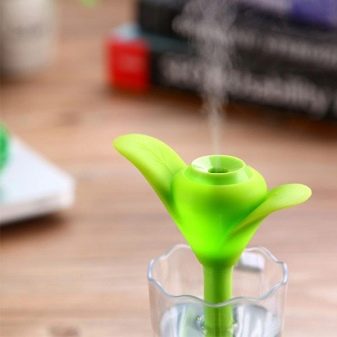

Lighting
The flower feels great in partial shade, but it needs light indoors for at least half the day. In hot climates, gardenias grow best where the morning sun hits the foliage. A space under tall trees such as oaks or pines works well. In the room, it is better to put the container on the south or west window. Too much gardenia shade grows with long stems, weak, thin leaves. They do not form enough flower buds, and those that do appear may fall off before they bloom. Flowers usually turn brown in strong sun.
Freezing, the plant begins to lose leaves or dies. To protect it from winter winds, experts advise planting a bush to the east or north of buildings or other structures.
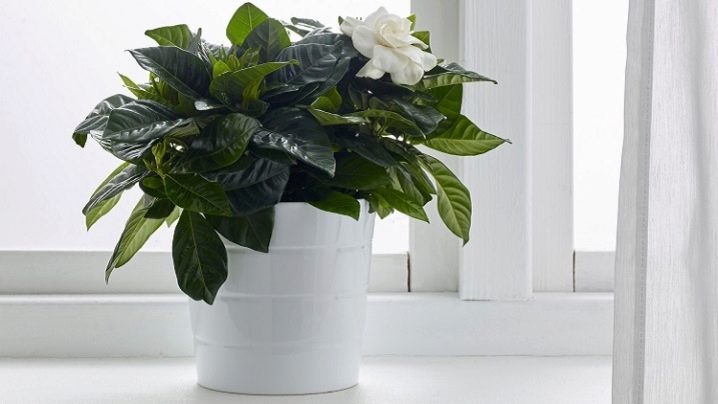
Priming
Dry, sandy ground or dense clay can negatively affect the health of your gardenia. Gardeners and plant breeders are advised to determine the pH of the soil and establish the amount of organic matter in it before planting. These flowers prefer a pH between 5.0 and 6.0. They also appreciate a lot of humus.
If the soil pH is above 6.0, you can lower it to the desired range using sulfur. In heavy soil with a large amount of clay and sand, an additional layer of bark or ready-made manure is added. You can use a layer of organic mulch around the base of your gardenias every spring. Mulching helps keep the garden soil moist and increases the organic matter content.
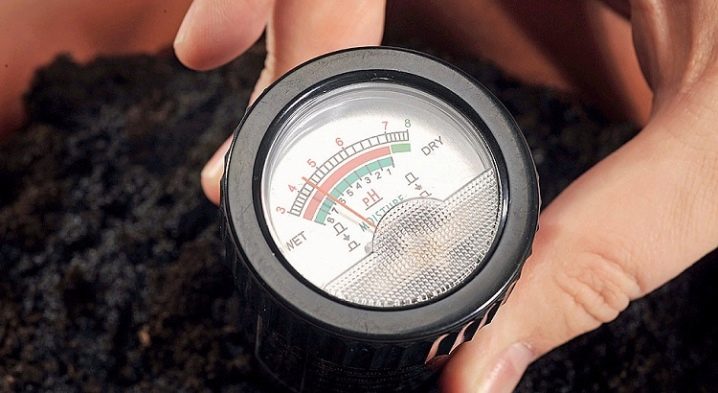
If the plant is grown in an indoor container, the shrub should not be in moist soil. A soil that is rich in organic material works well. The best planting time is autumn or spring.
To improve the potting mix, you must:
- use rich, nutrient-rich soil for the container plant;
- mix compost, needles or bark before planting a plant;
- add perlite or sand to the container for proper drainage.


Top dressing
To provide your home gardenia with all the minerals it needs, it is best to use liquid fertilizers. If you buy a ready-made complex, then choose one in which there will be no calcium - this mineral is contraindicated for gardenia, it has a bad effect on the growth and development of this plant.
The frequency of top dressing is once every two weeks
At the same time, pay attention to the well-being of the flower and the symptoms that sometimes appear on its leaves and petals.
So, if yellow spots are visible on the foliage, it means that the plant has a need for microelements, especially iron (about why gardenia leaves turn black, turn yellow and fall off and how to help the plant, read here). If a similar symptom is found, mineral feeding should be carried out more often - once every 7-8 days. Ready-made mineral compositions intended for orchids and azaleas are suitable for feeding. To provide the plant with all the necessary substances, you need to prepare the nutrient composition in full concentration, and not in half, as indicated on almost all fertilizer packages.
In addition to ready-made complex fertilizers, gardenia can be fed using home methods. So, you can buy a substance such as actiferrin at a pharmacy and dilute a tablespoon of it in a glass of clean water. The bush should be watered with the resulting solution once every two weeks.
What can be done to accelerate growth?
In order for the home gardenia to grow more actively, to increase its splendor and decorativeness, it is necessary to cut the flower from time to time. Pruning is done after the shrub has bloomed - that is, in the fall.
If you pluck young shoots during the growing season, the shrub will grow more luxuriantly, and it will also bloom more abundantly. Use the healthy and strong stems left after pruning for gardenia propagation - the finished planting material should not be lost.
Diseases of gardenia jasmine
- Falling buds. Reasons: insufficient watering, low ambient temperature or strong fluctuations, watering with cold water, insufficient lighting, moving the pot during budding and flowering.
- Perhaps the most common question is: Why do gardenia leaves turn yellow and fall off? Reasons: watering with cold or hard water, placing the plant on a cold windowsill.
- Gardenia leaves turn black. Reasons: excessive watering, sunburn. In case of burns, the damaged leaves are removed, and the plant is rearranged for a while in the shade.
- Faded leaves. Reasons: insufficient lighting, lack of nutrients, high humidity.
- The buds are tied but not opened. Reasons: insufficient lighting.
- Too small buds. Reasons: alkalization of the soil.
- Yellow streaks on the leaves. Reasons: alkalization of the soil.
The flower grows slowly, its appearance is depressed, but the leaves remain juicy and bright green. Reasons: damage by pests (spider mites, aphids, thrips, scale insects). In this case, you need to carefully examine the plant.
- If there are many gray dots on the top of the leaves, then the plant is damaged by thrips.
- The presence of sticky marks on the flowers indicates the defeat of aphids.
- When a spider mite appears, the leaves curl up into a tube, and lumps of cobwebs are visible at the base of these leaves.
- The scabbard leaves dark brown, round plaques on the leaves.
Regardless of what kind of pest settled on the plant, it is necessary to urgently remove the damaged leaves and process the bush with an insecticide, for example, actellik, intavir, aktara, phytoverm, etc. Treatment should be carried out 1-3 times a week.
Problems with growing gardenia
A beautiful plant needs special care, but not as complicated as it might seem at first glance. Knowing some of the features of gardenia, even an inexperienced florist can grow a flower.
Why gardenia leaves turn yellow and fall
The most common ailments are leaf problems. They lose color and fall off. The main symptom is unfavorable climatic conditions.
- violation of irrigation and water quality;
- unsuitable substrate;
- chlorosis associated with a lack of iron in the soil;
- insufficient lighting;
- depletion of the soil.
Gardenia does not tolerate both a lack of nutrients in the soil composition and an overabundance
Causes of blackening of plant foliage
There are several reasons for leaf blackening. Among the most common are:
- overdrying or waterlogging of the soil;
- drafts;
- the presence of pests such as spider mites;
- thermal burns as a result of exposure to ultraviolet rays on the leaves after spraying.
To prevent leaf damage, it is necessary to use iron-based fertilizing and water with water with the addition of lemon juice.
Overdrying or waterlogging of the soil is one of the reasons for the blackening of gardenia foliage
What to do if gardenia does not bloom
Possible reasons include:
- inconsistency in ambient temperature;
- lack of sunlight;
- lack of nutrients;
- too dry air;
- alkaline soil.
After correcting the shortcomings, buds will appear on the gardenia.
Gardenia's lack of bloom may be due to lack of sunlight.
How to avoid falling buds of gardenia jasmine
It is very annoying for flower growers when, instead of the buds opening, they begin to fall off. Why is such an unpleasant phenomenon happening?
- low air humidity;
- draft;
- sudden changes in temperature;
- changing the place of the flower pot;
- untimely transplant.
It is not recommended to rotate the flowerpot during flowering relative to the light source.
Care Tips

When gardenia buds are laid, you cannot touch it - turn the pot, change the location, otherwise the buds will fall off.
The plant loves warmth, therefore, in the summer, the optimal temperature for it in the room is 22-24 ° C. In winter, a temperature of 18-20 ° C is ideal for her. It should not fall below 16 ° C. During the period of bud formation, the optimum temperature for their preservation will be within 18 ° C. It is necessary to look after and protect the roots of the plant. as they react negatively to cold air or moisture. A sharp change in temperature can lead to disease and even death of the flower.
When the buds are just starting to develop, the plant needs high humidity. If there is dry air in the room, then the buds stop developing and begin to fall off.It is best to place the gardenia pot in a tray of damp expanded clay, provided that the bottom of the pot does not touch the water.
During periods of active growth of gardenia, increased air humidity is required. Her healthy development will depend on this. To do this, spray the plant, but only its crown, so that moisture does not get on the flowers and buds.
In the warm season, in spring and summer, the jasmine gardenia needs good watering so that the soil in the pot remains moist. The water should not be hard, settled and not cold. Experienced growers advise using filtered rainwater or boiled water for irrigation. In winter, watering should be reduced to keep it moderate. An excess of moisture and overdrying of the earthen coma should not be allowed.
Fertilizer and transplant

... The instructions indicate a certain amount
How to transplant gardenia jasmine? To do this, you need to prepare the soil, buy it ready-made or prepare it yourself. You must have 1 part:
- peat;
- deciduous;
- coniferous;
- turf land.
You should also add sand, moss or perlite. Moss will help make the soil more water-absorbing and improve its composition, slightly acidifying the soil.
It is recommended to replant young plants annually
To do this, carefully turn the container with the plant and then remove the flower along with a lump of earth. A more spacious pot must be used for transplanting.
After transplanting, be sure to add fresh soil and water the flower. It is only necessary to transplant once every few years an adult jasmine gardenia.
Leaves turn black and fall: reasons
With improper care, the plant is sick. The first signs may be blackened leaves, as well as dropping them. The most common reason for this:
- poor nutrition of the bush;
- weak root system.

If black spots appear
When damaged by pests, the leaves on the top of the plant begin to turn black. With a bacterial or viral disease of gardenia jasmine, there is a violation of nutrients in the upper part. Fungal diseases lead to the death of leaves. Fungicides help to cope with this problem. On a diseased indoor plant, all diseased parts are removed, and the healthy part is transplanted into a new container with new soil.
Reproduction
Jasmine gardenia can be propagated at home. There are two ways to do this:
- seeds;
- apical or semi-lignified cuttings.
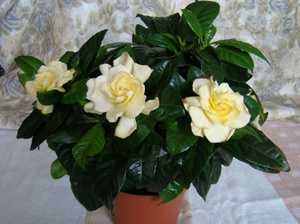 The seeds are harvested immediately after flowering. They are sown in a special container so that they do not lose germination. The first shoots can be seen no earlier than 1 month after sowing. They can thrive as long as they are constantly hydrated and tried to maintain an optimal temperature.
The seeds are harvested immediately after flowering. They are sown in a special container so that they do not lose germination. The first shoots can be seen no earlier than 1 month after sowing. They can thrive as long as they are constantly hydrated and tried to maintain an optimal temperature.
For planting by cuttings, shoots are used that were removed in the planned pruning of the bush. Pruning is recommended in May or September. The cuttings should be about 10 cm long. After that, they are planted in a moist substrate in a container and kept at a constant temperature of 22-24 ° C, but not higher. These conditions will allow the cuttings to take root well. A strong root system will make it possible to transplant them later into a separate small container. There they should grow until the root grows over the entire container. When the roots become cramped, the plants are placed in a regular pot.
Gardenia indoor
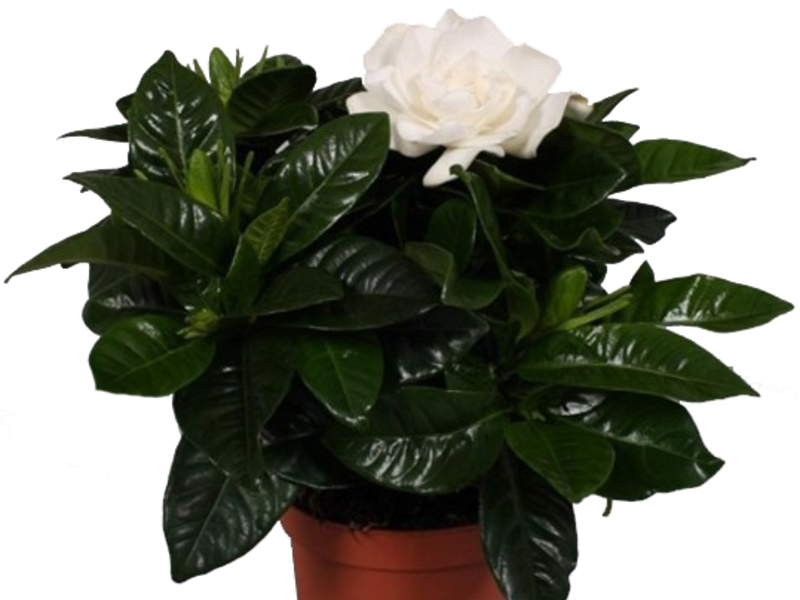




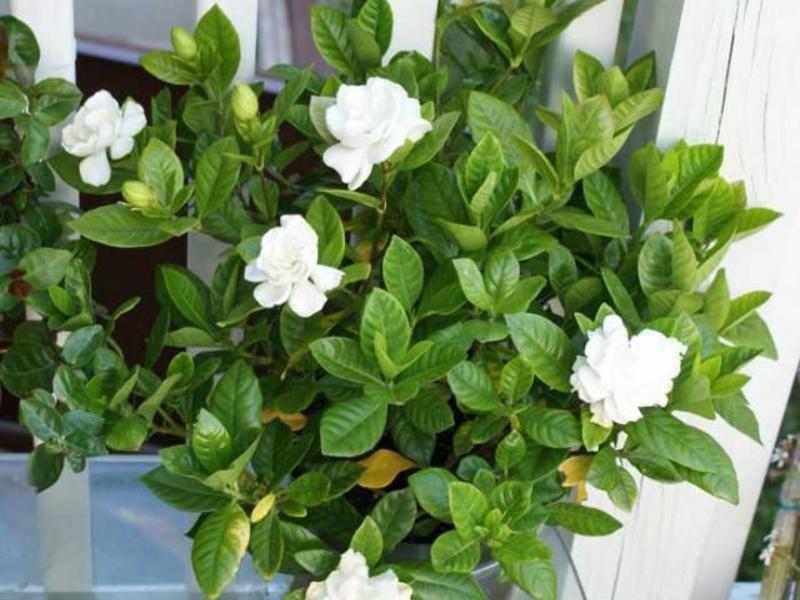
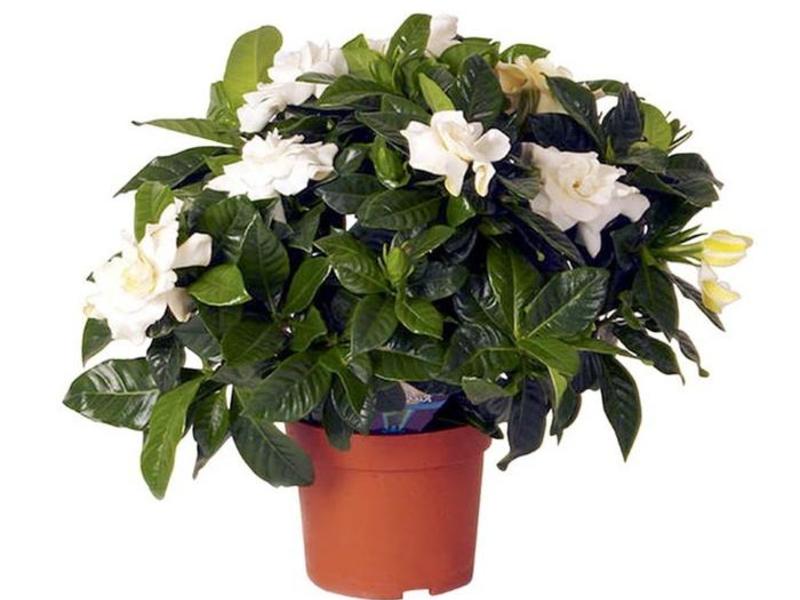

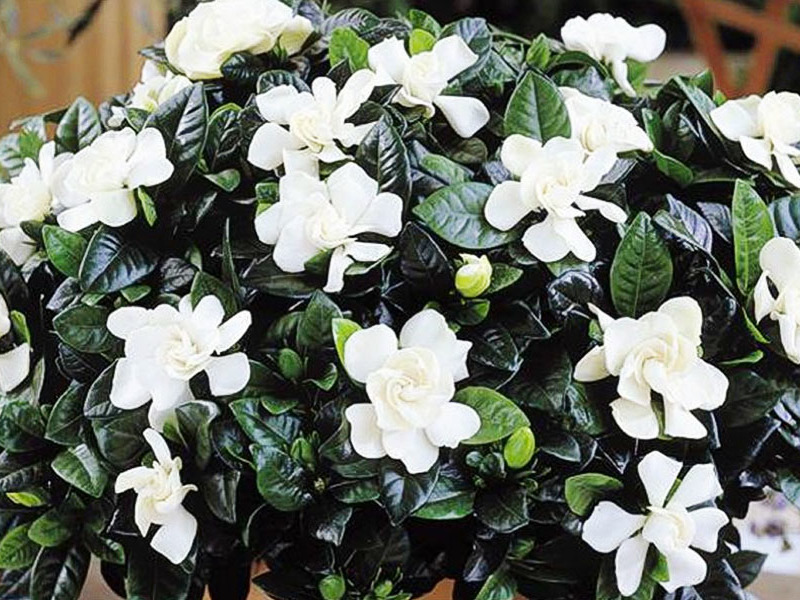



Varieties
Over a long period of cultivation, many varieties have been bred:

Beauty - 1.5-2 m tall, large double white flowers appear from early summer to autumn, abundant flowering. One of the most popular varieties.
-
Chuck Hayes - height 1.5-2 m, semi-double flowers, fragrant, ivory. Appears in early summer; single flowers may appear throughout the summer. The variety is characterized by increased cold resistance.
-
Belmont (Belmont) - densely double variety with large rounded leaves. The flowers grow up to 10 cm, with an amazing aroma.Possesses good cold snap resistance. The variety is resistant to diseases.
-
Amy (Aimee) - variety with the least dark foliage. Double flowers up to 12 cm are so perfect that they look artificial. Flowering occurs twice a year.
-
Mystery - 1.5-2 m high, with large dark green leaves, a very strong and popular variety. The flowers are very large, up to 13 cm, double, flat. It usually blooms twice a year. Tends to grow vertically.
-
Radikans (Radicans) is a dwarf compact bush 0.5-1 m high and up to 1.2 m wide with small shiny leaves. Terry flowers about 2.5-5 cm appear later than in many varieties, in summer. Ideal for bonsai.
-
Variegata is a variegated variety with medium-sized fragrant flowers (8 cm). A small shrub with a slow growth rate, well suited for growing in pots. The leaves are round, in color there are color transitions of various shapes from green to light cream.
-
Radican Variegata is a dwarf variety with variegated leaves, reaching 1 m in adulthood, very slow-growing. Dark green leaves with a creamy stripe along the edge. Flowers from 2.5 to 5 cm in diameter appear late, only in summer. Ideal for bonsai.
-
Golden Magic is characterized by long flowering and early transition of corolla color from white to golden yellow.
Description
Gardenia jasmine grows in the form of a bush with spreading branches, sometimes in an adult form it takes the form of a tree with several trunks. Indoor gardenia can reach no more than 50 centimeters in height, and a plant that grows in the wild sometimes stretches up to 180 centimeters.


The foliage is dark green, its base is not visible, since it is covered by stipules. Leaves never appear alone, only in pairs, and sometimes even 3 in one bunch. The leaf plate is glossy, has an ovoid shape; veins can be seen on its surface. Large flowers begin to bloom between June and October. They are visible from the axils of the leaves, at the tops of the branches. Sometimes they are solitary, and sometimes they are formed in groups of 6 buds. The corolla reaches 7 centimeters in diameter. There are varieties where it is terry, but it can be simple or even semi-double.
There is no great variety in color - the flowers are either yellow or white. It is difficult not to catch the aroma of the plant, since it is very sharp, somewhat reminiscent of jasmine bushes, but has a slight hint of citrus. The flowers are pollinated, after which fleshy, rather large fruits with a large number of seeds appear inside. When the fruit is fully ripe, it cracks.
Possible growing problems

A beautiful, but capricious plant often "complains" about the conditions of keeping at home. Let's analyze the possible difficulties in growing gardenia jasmine
Leaves turn black and fall

Dying flower
If a grower notices a similar symptom, urgent action is needed, otherwise the gardenia will quickly die. Reasons for blackening foliage:
Improper watering. Because of this, gardenia can rot its roots. You will have to check them visually by slightly pulling the plant out of the pot and examining the root system. Normally, the roots have a light shade. If darkening is noticeable, the damaged areas must be cut off with a sterile instrument and sprinkled with a disinfectant, for example, crushed activated carbon, over the cut sites. The plant is then transplanted into a clean pot with new soil. Watering must be reduced and carefully monitored for the well-being of the gardenia.
Drying out of the substrate. The lack of moisture is also not good for the flower. The biostimulator of growth Zircon can be added to the soil. The foliage is sprayed twice a day with a spray bottle
Low air humidity or high room temperature. Regular spraying will also help to avoid problems.
It is important not to place the gardenia pot near heating appliances.
Infestation by fungi, bacteria or pests
Foliage turns yellow or dries

Yellowing of leaves
Another unpleasant symptom is yellowing of foliage, especially noticeable against the background of normal dark green leaves. Often the situation arises due to insufficient production of chlorophyll by the leaves and is called chlorosis.
In this case, it is recommended to pay attention to the quality of the irrigation water. Hard and chlorinated tap water is harmful to the plant, only soft water can be watered
Dry foliage is caused by insufficiently acidic soil. It is recommended to add a little citric acid or a few drops of lemon juice to the water for irrigation.
Lethargy foliage, falling flowers

Gardenia jasmine indoor
This problem is observed when the plant is overcooled. It is necessary to check if the gardenia is standing in a draft.
Sometimes the foliage and buds also drop when the indoor air is too dry; it is necessary to correct humidification by spraying. Water for irrigation should not be cold. You can additionally purchase a humidifier at the store.
Small flowers, sluggish bloom

Gardenia jasmine
The flowering of gardenia or the growing season is a particularly crucial period for the owner: any changes in the conditions of detention will affect the condition of the flowers. It is not recommended to rearrange or rotate the gardenia during this period.
An exception is if the shoots turn pale and stretch, and the flowers become smaller in size: this indicates a lack of light.
Gardenia needs constant temperatures
If you feel unwell or when the plant does not want to bloom, you need to pay attention to whether there is a strong difference in temperature between the day and night
Pests

Mealybug
Unfortunately, gardenia is not immune to insects that parasitize it. Common pests are presented in the form of a table:
| Pest name | Symptoms | Control methods |
|---|---|---|
|
Mealybug |
A white, woolly bloom appears on the underside of the leaves, the plant can shed foliage. | You can wipe the foliage with a sponge dipped in methyl alcohol: this will remove the pest. It is also recommended to spray the plant with an insecticidal preparation. |
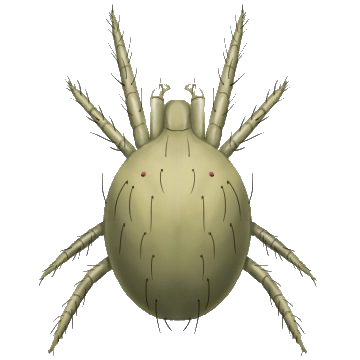
Spider mite |
The insect manifests its presence with a thin cobweb, twining twigs and leaves. | Gardenia regularly falls prey to this pest. It is necessary to arrange a shower for the plant, and then treat it with insecticides, for example, Decis. |
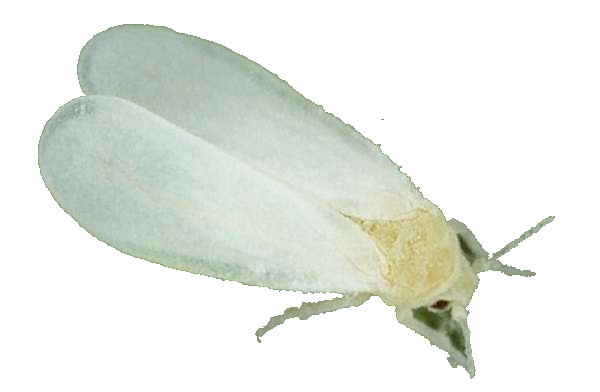
White aphid |
The pest leaves sticky sticky spots and spots on the leaves. The buds fall off. | Treatment with soapy water will help to cope with aphids. If this does not help, you will also have to use insecticides, for example, Neoron. |
Also, gardenia can be infected by scale insects and thrips.

Photo of gardenia infested with pests
Any plant affected by pests must be isolated. Otherwise, the infection will spread to other indoor flowers.
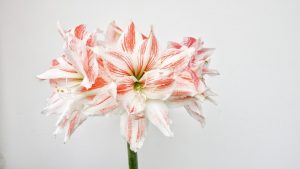
How to care for hippeastrum so that it blooms: rules and secrets of cultivation and reproduction | (Photo & Video)


